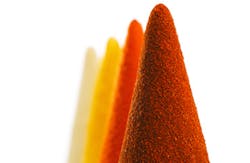"Well into the 21st century, we still do not possess a fundamental understanding of powder behavior," says a prominent page on the website of Freeman Technology.
Yet, "Granular materials are ubiquitous in nature and are the second-most manipulated material in industry — the first is water," says the material scientist Patrick Richard, quoted on Wikipedia.
For many educated generalists, both of the above observations might come as a surprise. But taken together they reinforce the notion that even for scientists and engineers how the world really works remains a mystery.
Of course, neither the physics of powders or granular material-and-powder applications and logistics get the kind of media attention as do the oil, gas and chemicals industries, where the processed particulars tend to be flowing liquids.
Nevertheless, scientists, equipment and instrumentation developers, engineers and industrial managers working with granular materials and powders have to get things done day-to-day in an information technology, software and automation-dominated world, while at the same time addressing some very "elemental" challenges.
What’s the idea?
What must seem most surprising about granular materials and powders to anyone first taking notice is how they seem to exhibit somethings that are as much like "behaviors" as they are "properties."
In some sense — it is said — granular materials don’t constitute a single phase of matter but have characteristics of solid, liquid or gas depending on the average energy per grain. However, in each state, granular materials exhibit unique properties.
Most notably, they exhibit pattern-forming behaviors when excited, vibrated or allowed to flow, including the segregation of unlike grains, formation of surface patterns, ripples, dunes and sandsheets.
Powders are a sub-class of granular material, with particulates having finer grain sizes and a greater tendency to clump. The clumping behavior that causes the individual grains to cling together is called the Van der Waals force.
Besides segregation, clumping and pattern forming, other behaviors said to be common to granular materials include stratification, jamming & unjamming, fragility, loss of kinetic energy, functional shearing, compaction and something called "Reynolds dilatancy."
Put into practice
Once having appreciated the unique properties of granular materials and powders, those charged with their processing and material handling must turn to more practical issues.
Not long ago, equipment manufacturer, Schenck Process LLC, Whitewater, Wisconsin, developed a dry material feeder that met the needs of the pharmaceutical industry.
Obviously, the first question is, to what use are feeders put to in the pharmaceutical industry? These uses include particle-size reduction, mix-tank and reactor charging, mixing, tablet coating, packaging and continuous granulation. Equipment capacities and feed rates needed for the applications must be understood.
Other design criteria were looked at. Bearing in mind the need for FDA-approved materials of construction, these included surface finishes of welds and metals used in fabrication; cleaning processes that called for frequent dis-assembly and assembly; validation practices; and feeding accuracy.
As is fairly well known, #316 stainless steel is the preferred material for pharmaceutical industry equipment, due to its corrosion, chemical and thermal resistance, say Chad M. Lorenson, pharmaceutical industry business development manager, and Andreas Ludwig, mechanical engineering manager, Schenck Accurate, in an article that first appeared at pharmaceuticalonline.com.
Lorenson and Ludwig go on to explain that EPDM is a widely accepted polymer used for components that have to be elastic, non-porous and FDA-compliant. Using EPDM within the feeder’s flexible hopper as a disposable component eliminated expensive cleaning needs.
Application features
As in the food and dairy-feeding worlds, welds on pharma-industry equipment must be continuous, non-porous and without cracks or undercuts, ensuring a machine can be easily cleaned. Large, smooth surfaces allow access for cleaning and maintenance and eliminate potential for water or solvent to remain in crevices.
In fact, 32 micro-inch roughness average (Ra) and 16 micro-inch Ra configurations were used in the example feeder.
Lorensen and Ludwig point out that use of stainless steel tri-clover-type clamps to secure the extension hopper and discharge nozzle as well as a continuously welded housing and agitator arm are steps that allow ease of dis-assembly. Fewer components in the product contact zone also reduce cleaning efforts.
Active pharmaceutical ingredients have different adhesive & cohesive properties and flow behaviors. Variable feeder control, by means of agitation, helps. Gravimetric feeder control allows for continual helix speed adjustments depending on the loss of weight over time. Consistent helix filling is critical for good discharge behavior.
Developing pharmaceutical feeders calls for collaboration with processing companies. As a result, unique design elements, like the disposable feeder hopper, provide a solution that meets real needs.
On-going mysteries
As Freeman Technology points out, it’s a common misconception that powder behavior can be described by just understanding its flowability, and that flowability is a discrete property that can be quantified by a single number.
This just isn’t the case. Despite comparable physical and chemical properties, loosely-packed and tightly-packed powders don’t act the same. The same is true regarding the influence of aeration and consolidation. What’s more, different materials react to the totality of these conditions in different ways.
Freeman says it’s a matter of how much stress is put on the material, with some being more sensitive than others. Processing speed, ambient moisture and time stored are other important factors.
In fact, if nothing else, when it comes to theory and practice in granular materials and powders, simply saying there "are many factors involved" is something of an understatement.
Freeman Technology is a UK-based maker of systems for measuring powder flow properties, including so-called rheometers, which use an automated shear cell and several bulk-property tests, including density, compressibility and permeability.
The name Schenck Process is synonymous with more than 125 years of bulk material handling experience. Originally founded as an iron foundry and weighing machine factory, it has grown to become one of the global market leaders in applied measuring and process technology.


